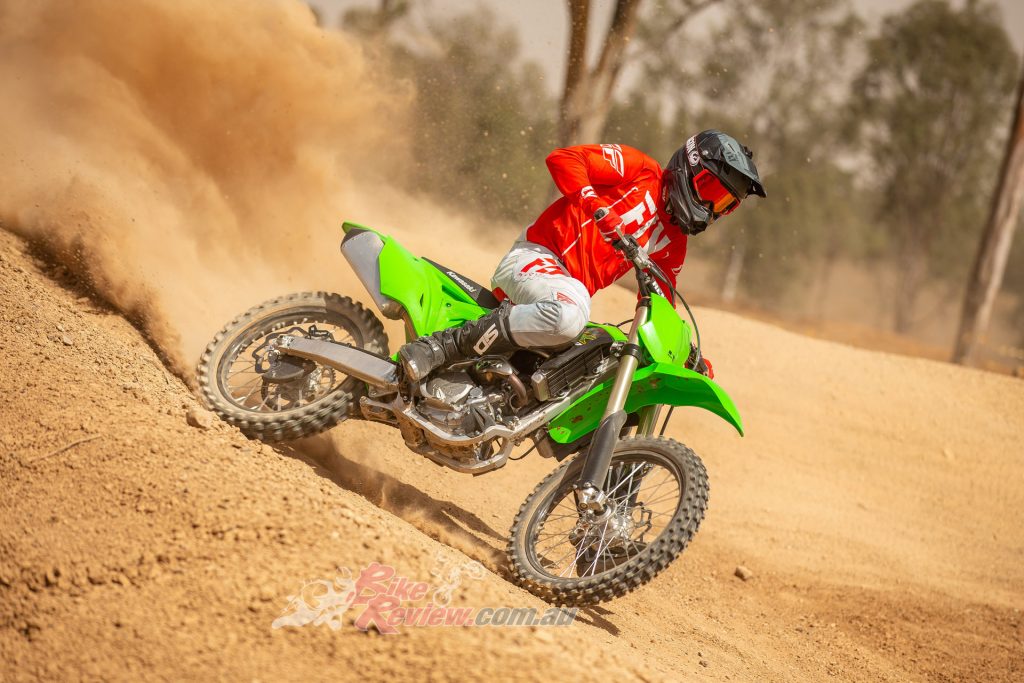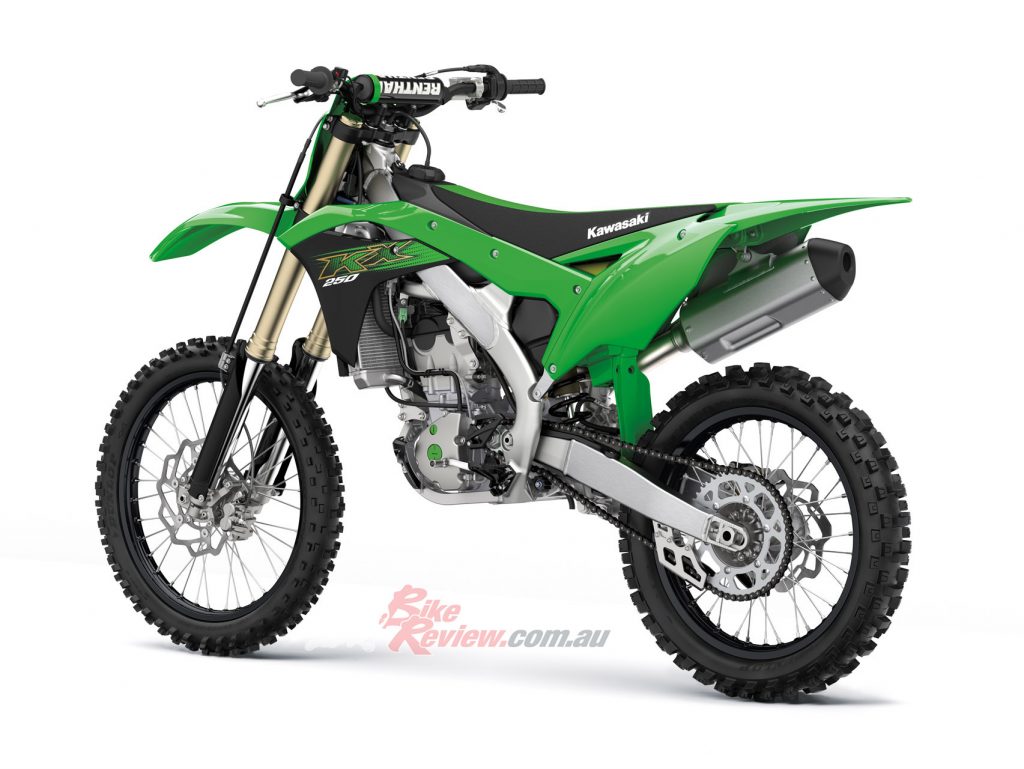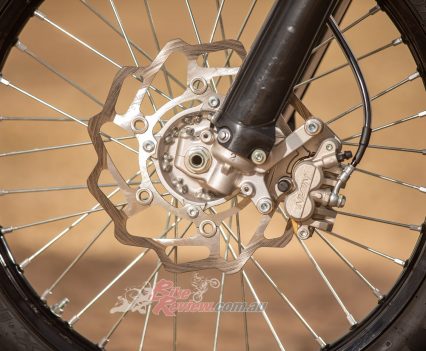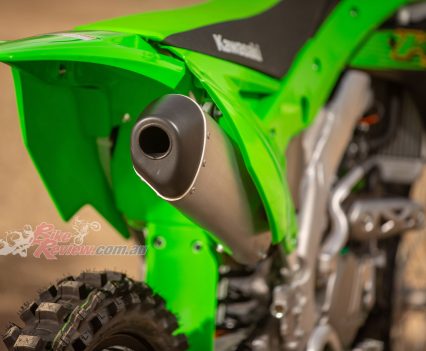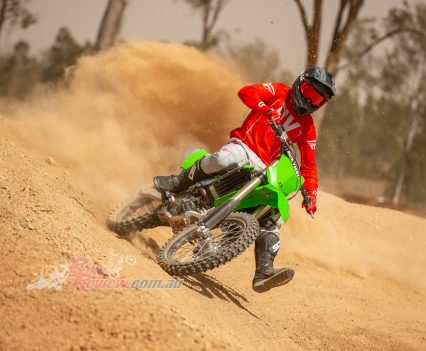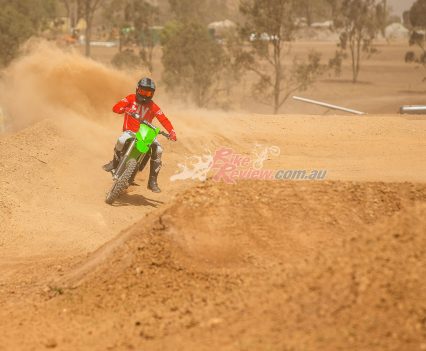Major engine changes have upped the power and improved delivery of the KX250, while new KYB suspension has improved the ride... Here is our 2020 Kawasaki KX250 review... Test: Guy Streeter Photography: iKapture
The new generation of Kawasaki KX250 has been around for a couple of years now, the 2019 model didn’t receive too many updates at all aside from the F being dropped from the KX250F.
For 2020, however, Kawasaki have come out with a host of changes to the motor, suspension and brakes. We were lucky enough to have access to the 2020 Kawasaki KX250 for a couple of weeks and we were able to visit a couple of local tracks in South-East Queensland to get a good feel of the new model. Check out our 2020 KX250 review…
The 2020 Kawasaki KX250 has hit the nail on the head. Kawasaki’s design philosophy was to put mid-level to expert riders on the top step of the podium to continue the KX250 history of winning. 2019 has been an incredible year for the green manufacturer with multiple race wins in both the 250 East and West championships as well as taking out the AMA 250 MX title with Adam Cianciarulo, so 2020 appears to be another strong year for Kawasaki in America and in Europe.
So what did we think about the 2020 KX250? As soon as you throw your leg over the 2020 MX weapon you feel right at home. I am of average height and weight (180cm, 80kg) and the ergonomics of the bike feel very natural and slim to me. But for shorter riders or even taller riders Kawasaki have made the cockpit easily adjustable, with adjustable footpegs, and ‘bar mounts.
I did move the ‘pegs to try the different adjustability of them but returned them to the stock position. Taller riders might want them lower but I felt the stock position to be good. The seat and bodywork of the 2020 KX250 are narrow and feel smooth between the legs, adjusting body position forward and aft is now easier and more consistent in the movement. Bar mounts in the stock position are very comfortable for me. I did move them back on the sandier track I rode at for a couple of laps but then returned them as they felt more natural for my size.
Riding the bike feels really slim and comfortable, moving around the bike, forward and back feel effortless, especially with the shroud that runs from the front of the tank back to the airbox. Moving from the standing and leaning back into braking and sitting down for corners flows really easily.
The brakes feel very good at the front, the 270mm diameter front brake has outstanding braking power, the lever pull is very progressive and you will have no dramas pulling up the KX250. For 2020 Kawasaki have changed the brake pad material, which has helped increase the controllability and feel.
The rear brakes have also been refined with a lager disc, which is now 250mm rotor and although I did have some initial objection to the rear brake locking up very easily and found it was very grabby (the rear brake disc has been increased by 10mm), adjusting the rear brake lever height down helped this a little, I thought maybe the brake pads would wear in and be less aggressive but they remained very strong. After a couple of rides I felt fairly comfortable and found on the tracks with more traction that it was an obvious advantage.
The only major fault I can find with the bike is the lack of electric start, but once you are riding, does it matter? Only in a racing situation. It is getting to the point where it wont be far off being added to the bike, but if you have been riding another brand that has an electric leg then it might be hard to go back to kicking the bike into life. I guess when you look at it there are advantages with not needing to keep the battery charged and the bike is a little more simpler…. but stalling the bike on a hot day, after a crash halfway through a moto and losing extra positions, I don’t think you will ever think about the added weight an electric start will add to the bike… ever.
Bring on 2021 with an electric start please Kawasaki.
The new suspension is a big improvement over the Single Function Fork from Showa on the previous model. The feeling from the coil spring KYB fork is far superior and to be honest who the hell wants to be checking fork air pressure every time you ride? The 2020 KX250 has a very neutral front to back suspension feeling and is very forgiving, offering better traction in the front-end, plus more stable on the straights and chopped out sections of the track.
The KX250 handles exceptionally well, tipping into corners and ruts with ease, even in some of the deeper and longer ruts. The KX250 also changes direction really easy and doesn’t feel like you need to fight the bike and push it too hard to get the bike to change direction.
Dunlop tyres are fitted front and back on the 2020 KX250 and its easy to see why, they suit a wide range of terrain and have really good feel front and back, you wont be guessing where the limit is and finding the ground before you find the traction point. Really consistent and good grip on a range of surfaces.
The engine response is really good off the bottom and in comparison to the 2019 KX250 the engine pulls a lot harder in the mid to top-end and feels a little bit more freer revving. On the two tracks that we tested at the soft coupler didn’t get more than a lap or two before settling on the more aggressive coupler. The softer coupler would work well on dusty hard pack tracks or in muddy slippery conditions. The only problem I found with the couplers was the pain of needing to manually change them and you couldn’t do it on the fly while you were riding. It was almost like being sent back to the 1980s when you had to get up from the couch, walk over and change the channel on the TV. There are several other bikes on the market that have a switch on the handlebar that you can cycle through a couple of different settings while you are riding. Having said that, Kawasaki have three different settings you can use where the others only have two. So I guess you win some you loose some right?
Another stock gadget is the Launch Control, normally reserved for an aftermarket device, the Kawasaki Launch Control is perfect for getting off the line and getting all the power you possibly can to the ground without the bike wheelstanding and rear tyre spinning and not getting drive to the ground. If you are just a trail rider or weekend warrior this probably wont get used often but for the racer this is exactly what you need. After a couple of practice starts without the launch control with varying results I used the launch control on several practice starts and was really surprised with the consistent starts I was able to do.
The new engine has made the bike feel more playful and fun. One area I feel you notice the gains made is from third gear onwards down the straights, the over-rev and HP is more noticeable in this part of the track, more so than the tighter corners. Overall the 2020 KX250 is certainly no slouch in the power department, you might not notice it as much down low, but on the faster parts to the track the motor just keeps pulling.
Overall, the 2020 KX250 is proves a good job by Kawasaki refining an already winning package for 2020. With electric start, the bike would be near perfect…
TECH TALK
ENGINE
The most significant of changes to the 2020 KX250 lay inside the engine. The quarter-litre four-stroke motocross market is the hottest contested as far as horsepower is concerned. Over the last few years everyone has been playing catch up to the YZ250F and Kawasaki took aim at bridging the gap and increasing power delivery at the higher end of the rev range, Increasing the rev limit by 500rpm and making more power.
The most prominent of the changes to the KX250 engine is the finger follower valve train, which the 2019 KX450 adopted from Kawasaki’s road bike, the ZX-10R. This allows for a higher rev limit and more aggressive cams. Accompanying the finger follower valve train is a larger piston, shorter stroke crank and a new airbox intake, downdraft-style intake, plus dual injectors.
The bore is 1mm larger with 1.4mm less stroke, this is accompanied by a 1mm larger throttle-body. The piston crown has been revised for increased compression.
Getting the show on the road still requires a kick via the kickstart which is easy enough when the bike is cold, but when the bike was hot took an extra kick or two to get it fired back up. Since the KX450 now has an electric start, we can only assume it is only a matter of time before the younger brother KX250 receives the same hardware.
Engine tuning is made relatively easy with the choice of 3 DFI couplers. The rider can use one of three different couplers to significantly change the mapping of the bike and change the characteristics of the engine. The choice of Standard, Hard and Soft mappings, which can be further manipulated using a KX FI calibration kit, which can be purchased from Kawasaki.
In addition to this, the Launch Control Mode feature is a must have which has been around for a while now as an aftermarket product, Kawasaki fit this to their bikes as standard and it comes in handy obviously for race starts.
CHASSIS
Kawasaki have stepped away from the Showa single function fork, which was widely regarded as a difficult fork to tune and keep a consistent feel for. 2020 sees Kawasaki adopt the KYB 48mm inverted spring coil fork and the new Uni-trak shock set-up has been updated as well featuring dual compression adjustability for low and high speed damping. Both the KYB fork and shock have had a stiffer spring rate over the 2019 model. The KYB fork returns more control and predictability to the forks, which was lacking on the 2019 Showa equipped KX250 and provides a much better ride over all surfaces from small hard bumps to the harder landings and G outs.
As mentioned the 2020 KYB suspension is a spring rate stiffer and allows the forks to stay up a bit more in the stroke and also provides better feeling and traction in the front-end. The bike felt planted and provided more traction in the dusty hard pack conditions while braking hard – and tipping into ruts felt good and confidence inspiring. The rear suspension felt well planted and stable.
The Kawasaki KX250 chassis updates were not very significant for 2020 with most of the gains focused on the engine, suspension and power production. The KX250 features a slim, lightweight aluminium perimeter frame with focus for 2020 on changing the engine mounts and now using through-stud bolts. The engine mounts are now lower, which assists in bringing the centre of gravity down and allowing the rear suspension to work smoother and maximise traction.
Brakes have been improved with better stopping power via an oversized semi floating 270mm front disc and a larger 250mm rear disc. Both front and back brakes are improved and provide a great linear feeling, although the rear brake did feel very strong and locked up the rear wheel pretty easily.
Ergonomically the 2020 KX250 retains that narrow frame and minimalistic bodywork. Complimenting the new bodywork, Kawasaki have used Ergo-fit adjustable handlebar mounts and footpegs. Factory style Renthal aluminium handlebar is standard with the adjustable upper triple-clamps having four different positions for the handlebar mounts (25mm and 10mm forward, standard position and 10mm back).
Minimalistic shrouds were fitted making the contact area for the riders legs to be easier and smoother. The tank area of the seat is flatter and this allows the seat to be flatter and smoother making it easier for the rider to move weight forward. The seat uses a slip-resistance top surface for rider grip when seated, while the sides of the seat are smoother to allow better mobility.
2020 Kawasaki KX250 Specifications
Price: $10,699 RRP
Claimed Power: N/A kW[hp]@rpm
Claimed Torque: N/A Nm[lbs-ft]@rpm
Wet Weight: 105.2kg
Fuel capacity: 6.4L
Engine: Liquid-cooled, four-valve, DOHC, single-cylinder four-stroke, 78 x 52.2mm bore x stroke, 249cc, 14.2:1 compression, semi-dry sump, fuel injected 44mm throttle-body, CDI ignition
Gearbox: Five-speed, 1st-5th, 30/14, 28/16, 26/18, 21/17, 23/22, 67/20, 50/13-final gearing 13/50
Clutch: Wet multi-plate, cable actuation
Chassis: Tubular-steel, semi-double cradle frame
Rake: 28.6°
Trail: 130mm
Suspension: 48mm inverted KYB forks, fully adjustable, 314mm travel, KYB shock, Uni Trak, fully adjustable, 310mm travel
Brakes: 270mm rotor (f), twin-piston caliper and conventional master-cylinder, 250mm rotor (r), single-piston caliper
Wheels & Tyres: 80/100-21F, 100/90-19R
DIMENSIONS
Wheelbase: 1480mm
Seat height: 948mm
Ground clearance: 333mm
Overall width: 820mm
Overall Length: 2172mm
Overall height: 1269mm
2020 Kawasaki KX250 Gallery
The Verdict | Review: 2020 Kawasaki KX250














